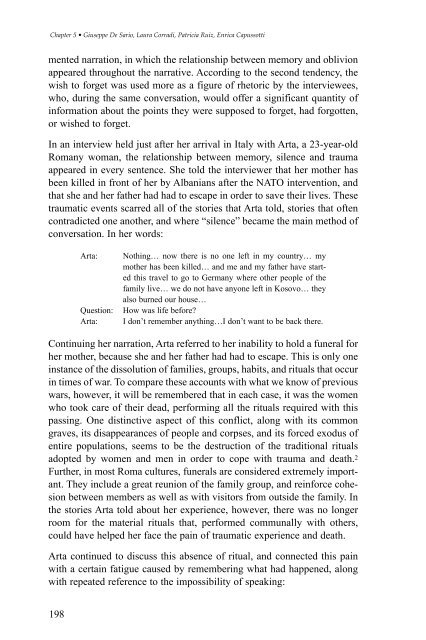Psychosocial Notebook - IOM Publications - International ...
Psychosocial Notebook - IOM Publications - International ...
Psychosocial Notebook - IOM Publications - International ...
You also want an ePaper? Increase the reach of your titles
YUMPU automatically turns print PDFs into web optimized ePapers that Google loves.
Chapter 5 • Giuseppe De Sario, Laura Corradi, Patricia Ruiz, Enrica Capussotti<br />
mented narration, in which the relationship between memory and oblivion<br />
appeared throughout the narrative. According to the second tendency, the<br />
wish to forget was used more as a figure of rhetoric by the interviewees,<br />
who, during the same conversation, would offer a significant quantity of<br />
information about the points they were supposed to forget, had forgotten,<br />
or wished to forget.<br />
In an interview held just after her arrival in Italy with Arta, a 23-year-old<br />
Romany woman, the relationship between memory, silence and trauma<br />
appeared in every sentence. She told the interviewer that her mother has<br />
been killed in front of her by Albanians after the NATO intervention, and<br />
that she and her father had had to escape in order to save their lives. These<br />
traumatic events scarred all of the stories that Arta told, stories that often<br />
contradicted one another, and where “silence” became the main method of<br />
conversation. In her words:<br />
Arta: Nothing… now there is no one left in my country… my<br />
mother has been killed… and me and my father have started<br />
this travel to go to Germany where other people of the<br />
family live… we do not have anyone left in Kosovo… they<br />
also burned our house…<br />
Question: How was life before?<br />
Arta: I don’t remember anything…I don’t want to be back there.<br />
Continuing her narration, Arta referred to her inability to hold a funeral for<br />
her mother, because she and her father had had to escape. This is only one<br />
instance of the dissolution of families, groups, habits, and rituals that occur<br />
in times of war. To compare these accounts with what we know of previous<br />
wars, however, it will be remembered that in each case, it was the women<br />
who took care of their dead, performing all the rituals required with this<br />
passing. One distinctive aspect of this conflict, along with its common<br />
graves, its disappearances of people and corpses, and its forced exodus of<br />
entire populations, seems to be the destruction of the traditional rituals<br />
adopted by women and men in order to cope with trauma and death. 2<br />
Further, in most Roma cultures, funerals are considered extremely important.<br />
They include a great reunion of the family group, and reinforce cohesion<br />
between members as well as with visitors from outside the family. In<br />
the stories Arta told about her experience, however, there was no longer<br />
room for the material rituals that, performed communally with others,<br />
could have helped her face the pain of traumatic experience and death.<br />
Arta continued to discuss this absence of ritual, and connected this pain<br />
with a certain fatigue caused by remembering what had happened, along<br />
with repeated reference to the impossibility of speaking:<br />
198

















